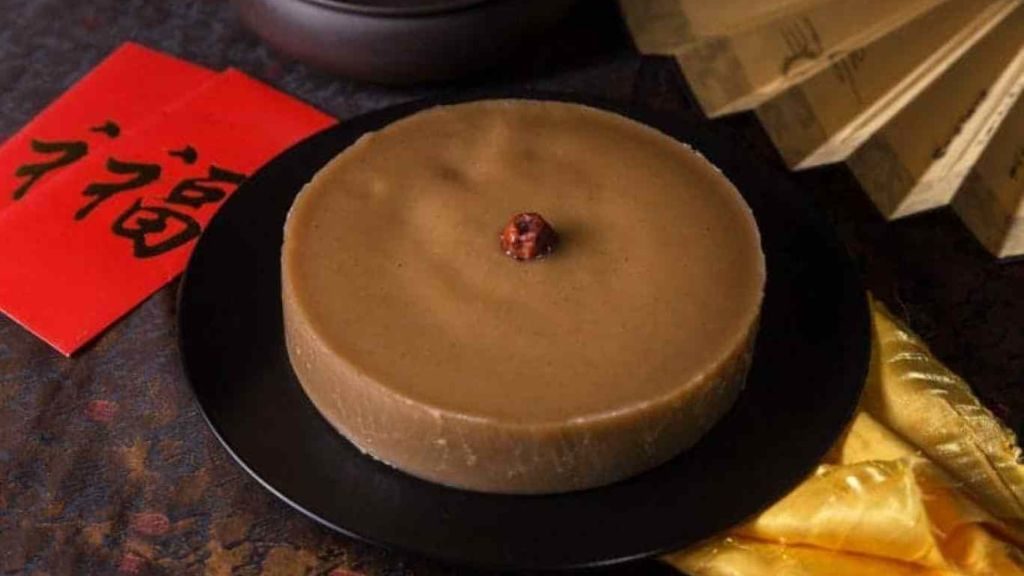A sweet, sticky dessert that is a must-have during Chinese New Year. Every family will serve this sweet Nian Gao to celebrate the new year. It symbolises prosperity and good luck for the upcoming year.
However, this Chinese New Year dessert isn’t limited to only the new year. You can easily find it all year round!
What is Nian Gao?
The word ‘nian’ refers to the sticky texture of the dessert, while the term ‘gao’ means cake. Nian Gao is also a pun of ‘year high’, symbolising promotions or prosperity in hope for a better new year.
This dessert is made from glutinous rice flour, water, and sugar. People usually steam this dessert before serving. This sticky dessert can also be fried, causing it to be crispy on the outside and chewy on the inside.
However, this dessert is not only served for guests during the festival. It’s also a popular gift, coming in different shapes and sizes.
The traditional Nian Gao will have prosperity in traditional Chinese script on top of it. This signifies good wishes for the New Year.
Its History
The Nian Gao has been around for more than 1000 years. During the Liao Dynasty (907-1125), people had a custom of eating new year cakes on the first day of every new year.
This custom continued until the Qing Dynasty (1644-1911). At that time, Nian Gao had already become a typical everyday snack.
Originally from China, it soon spread to other Asian countries. The Nian Gao influenced other rice-related cake desserts and food in these countries. For example, mochi from Japan and tteok from Korea.
The traditional methods for preparing this cake dessert can take about 10 to 12 hours. That is the time required for the sugar in the cake to caramelise. Even though more modern and quick cooking methods have been introduced over the years, many people, especially in rural areas, prefer this traditional cooking method instead.
Different Types
Nian Gao has many varieties depending on the regions or country. The Chinese version also differs between Cantonese Cuisine, Fujian cuisine, Shanghai and Northern cuisine.
The Cantonese version is usually sweet and dark yellow. It is served in thick slices after being steamed.
For the Fujian version, the Nian Gao has a natural amber colour. It is made from glutinous rice with taro. The sliced Nian Gao needs to be cook before eating.
The Shanghai cuisine mixes rice with the glutinous rice, so it is white. The ratio between rice and glutinous rice depends on personal preferences. If you prefer your sticky dessert to be softer, you need to mix in more glutinous rice compared to rice.
There are many cooking methods for this cake dessert such as steaming, frying, or in a soup. So, it can be sweet or savoury depending on the ingredients.
Northern Nian Gaos are mainly sweet, mixed with many different ingredients. For example, red bean paste or jujube paste for the filling. There are also green beans, red dates and yellow rice.
In Malaysia, this dessert is also known as kuih bakul. It is usually fried with pieces of taro or sweet potato in between. Besides that, there are different ingredients such as red bean paste or lotus seed paste that can be mixed with the cake dessert as well.
Where can you find Nian Gao in Malaysia?
This soft, sticky and delicious cake can be easily found in local supermarkets. During Chinese New Year, there are many types of Nian Gaos available. but if you crave this cake outside of the festival season, try to get it from I Love Yoo! (Muar) or Hani Steam Food Restaurant (Kuala Lumpur).
Find more of the Chinese cuisine on foodpanda!
Looking for other CNY desserts instead? Here are 8 popular Chinese New Year desserts that may interest you!
